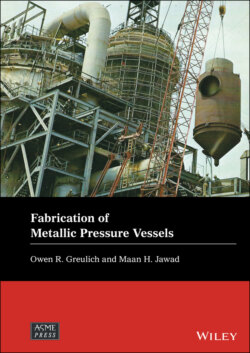Читать книгу Fabrication of Metallic Pressure Vessels - Maan H. Jawad - Страница 25
1.3.2.8 Forming
ОглавлениеVessel fabricators will usually use one of four ways of making vessel shells.
First, as noted in Section 1.3.2.3.3, the least expensive way of producing a vessel shell is almost always to purchase a standard size of pipe, if it is available. This is usually true even for rolled and welded pipe.
Second, if large quantities are to be produced, is to develop dies and form shell sections using a large press. The cost of this tooling, even ignoring the cost of a press large enough to perform this type of work, is high, and it will only be justified by large quantities of product. For large quantities, however, this approach allows the production of shell sections (usually halves or thirds) with a single stroke of a press. Even the cost of installing the dies may be fairly high, and may not be cost effective for single vessels.
Third, rolled shell sections may be produced using forming rolls as described in Section 4.3, followed by placement of longitudinal welds. This technique is especially useful for diameters and shell lengths that can be rolled out of a single piece, since it efficiently produces cylinders requiring only a single longitudinal weld.
Finally, shells can be produced on a press brake. This is usually more labor intensive than either forming rolls or forming dies, but for small quantities of shell courses or if control of all aspects of the production is needed, it can make sense. For a company possessing a press brake but not forming rolls, rolling of pressure vessel shells can be accomplished in either of two ways: first, the shell can be “bump rolled” on the press, usually in sections, and second, the company can either buy the finished product or send shell material to a fabricator possessing a set of rolls for rolling. If the first approach is taken, the labor cost for bump‐rolling itself is probably greater than that for a product produced using forming rolls, but the cost of extra layout, pre‐crimping or cutting off extra material allowed in place of crimping (thicker sections), and shipping the product both directions are eliminated. Thus, for a single product, bump‐rolling may be adopted, while the second approach is likely if a number of shells are required and the roll setup costs can be better distributed over the number of shells produced.
If a very large quantity of the product is to be produced, particularly if it is to be produced on an ongoing basis, then a company may invest in a set of forming rolls. The cost of the rolls is then amortized over the life of the product line, costs go down, and the company has a new capability.
